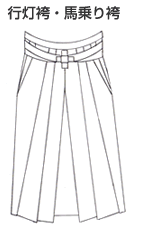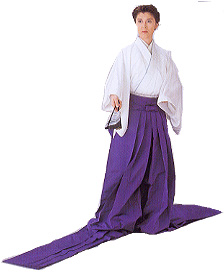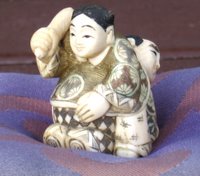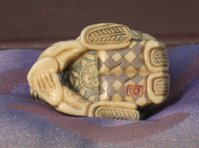:::::::::::::::::::::::::::::::::::::::::::::::::::::::::::::::::::::::::::::::::::::::::::::::::::::
Formal trouser-skirt (hakama)
***** Location: Japan
***** Season: Non-seasonal Topic
***** Category: Humanity
*****************************
Explanation
Below two kigo with this garment and the Shichi-Go-San Festival are also introduced.
The formal trouser-skirt (hakama はかま 袴) is still used in many ceremonies, martial arts and other formal activities today. I used to wear one during practise of Japanese archery (kyuudoo 弓道). These pleated long pants for formal wear are rather difficult to put on and even more so to fold correctly after wearing. I remember well many hours spend with my archery teacher just learning how to fold this garment properly. The seven folds are of course meaningful, there are five in the front and two in the back and you think about the following topics while folding your garment:
yuuki = courage, valor, bravery
jin = humanity, charity, benevolence
gi = justice, righteousness, integrity
rei = formal etiquette, courtesy, civility
..... (also formal bowing and obeisance)
makoto = sincerity, honesty, reality
chuugi = loyalty, fidelity, devotion
meiyoo = honor, credit, glory; reputation, dignity, prestige
This trouser-skirt is worn by men and women. Young boys get the first hakama at age 5 during a special ceremony, see below.
During the Edo period, a hakama would also protect the kimono when walking or working outside or travelling. These garments were lined with a special strong black cloth at the bottom of the legs. The normal material was strong cotton.
For theater performances, lavishly embroideree silk hakama were also commen.
During the Heian period, ladies wore bright red hakama over their kimono.
Gabi Greve
The costume of the mountain ascetics (shugenja) includes a hakama with very wide legs, bound at the bottom.
Shugendoo, The Mountain Ascets Way of Life
修験道、山伏の生き方
by Gabi Greve
This one is for formal horse-riding,
joba hakama, jooba hakama 乗馬袴.

Click HERE to see some more.
The "Top-Bottom", kamishimo 裃 garment was the formal wear of a samurai. It was usually emproidered with the family crest.
Click HERE to see some samples.
xxxxxxxxxxxxxxxxxxxxxxxxxxxxxxxxxxxxxxx
Hakama is an outer garment worn over the kimono that are either split between the legs like pants or non-split like a skirt. Hakama pants originated as an outer garment to protect samurai warriors legs from brush when riding a horse. Today, the hakama is worn as formal attire for ceremonies, traditional japanese dance, artists and martial arts.
The hakama pants with the split between the legs are the most well known. However, hakama used for traditional japanese dances and ceremonies normally do not have a split for it allows the full length kimono underneath to hang nicely giving a neater appearance. Both hakama styles (skirts and pants) look exactly the same from the front and back.
Traditional hakama pants for men are striped or solid in subdued colors. The striped black and gray hakama pants as shown on the right is the most popular traditional attire. The formal attire consists of a white under garment, black full length kimono, hakama pants and a black haori.
© Japanese Kimono.com
:::::::::::::::::::::::::::::::::::::::::::::::::::::::::::::::::::::::::::::::::::::::::::::::::::::
Wearing the hakama for the first time, hakamagi 袴着
kigo for early winter
This is a special ceremony performed formally on the 15th day of the 11th month, now in November during the festival of "Seven Five Three" Shichi-Go-San (see below).
Little boys of five are given their first hakama by a special friend of the family, his new "hakama parent" hakamaoya 袴親, who dresses the boy and brings him to the temple/shrine for the ceremony. Thus the two families would be closely bound together.
At the imperial court, this ceremony is called
"Chakko no Gi" 着袴の義, and also performed for girls.
Here is our princess Aiko with her royal parents.

© Photo Today24h一覧
袴着や子の草履とる親ごころ
hakamagi ya ko no zoori toru oyagokoro
小西来山
Here is one from Kamakura, where I watched this ceremony many times.
First Hakama Ceremony!
a little samurai passes
the Big Drum Bridge
Gabi Greve
Big Drum Bridge, Taikobashi, is the famous bridge before entering the shrine compound at Hachimangu Shrine in Kamakura.

Haiga by my friend Nakamura Sakuo
Everyday Issa Haiga
:::::::::::::::::::::::::::::::::::::::::::::::::::::::::::::::::::::::::::::::::::::::::::::::::::::
Long formal trousers, nagabakama 長袴
You have to step on the long legs whilst walking, and you have to be careful of the people walking behind you!
This was worn on formal audiences and you had to walk almost on your knees, thus avoiding that a samurai could draw his sword unexpectedly to attack his lord.

In the famous story of the "47 Ronin" the trouble begins with a long hakama of the Lord being stepped on by the unfortunate young samurai.
Look at more here:
© "Getting Dressed in Edo" Graphics Gallery
Refresh your memory here:
Sengaku-ji and the 47 Ronin (Chushingura) 泉岳寺と47浪人 / 忠臣蔵
By Gabi Greve
.................................................................................

Click HERE to see some more.
:::::::::::::::::::::::::::::::::::::::::::::::::::::::::::::::::::::::::::::::::::::::::::::::::::::
Noh-Performance in Hakama, hakama noo 袴能
kigo for late summer
Usually a mask and heavy costumes are worn for a Noh performance but on the hotttest days of summer, the actor wears only a hakama with a family crest. All the other tools of the stage are used as usual. In this lighter dress, the audience can see the movements of the actors a lot better than when using formal costumes. It makes them all feel cooler during the hot days.
:::::::::::::::::::::::::::::::::::::::::::::::::::::::::::::::::::::::::::::::::::::::::::::::::::::
Two People in One Hakama, futaribakama 二人袴
This is a famous Kyogen play about a father and son, who are forced to share one pair of fancy trousers.
Click HERE to see some more.
I have an ivory netsuke with two people sharing one hakama.


The bottom too is delicately carved.

*****************************
Worldwide use
*****************************
Things found on the way
*****************************
HAIKU
. Kobayashi Issa 小林一茶 Issa in Edo .
袴着て芝にころりと子の日哉
hakama kite shiba ni gorori to ne no hi kana
first day of the rat -
he fell asleep on the lawn
in his formal trousers
わか草にべたりと寝たる袴哉
waka-gusa ni betari to netaru hakama kana
on the young green
he is fast asleep -
in his formal trousers
Tr. Gabi Greve
The first day of the rat (hatsune) was a special day of the New Year with ceremonies where people used to wear a formal dress for the day of the rat, ne no hi goromo 子の日衣.
David Lanoue translates this hakama as "sword's sheath" .
xxxxxxxxxxxxxxxxxxxxxxxxxxxxx
Two more haiku by Issa
としよりの高股立や今朝の霜
toshiyori no takamomodachi ya kesa no shimo
the old man's skirt
hiked up his thighs...
morning frost
Takamomodachi means that a formal skirt (hakama) has been raised on both sides, making physical activity possible, a vigorous posture; Issa zenshû 2.148, note 1; Kogo dai jiten (Shogakukan 1983) 986.
長月の空色袷きたりけり
naga tsuki no sora iro awase kitari keri
Ninth Month--
the sky wears a colorful
lined kimono
The editors of Issa zenshû leave the original text of this haiku mysterious. In Volume 1 the sky is wearing hakama, a man's formal divided skirt or woman's pleated skirt. But in Volume 2 the sky is wearing awase: a lined kimono (Nagano: Shinano Mainichi Shimbunsha, 1976-79) 1.429; 2.370. I have decided to base my translation on Vol. 2.
Since Ninth Month is the end of autumn, even the sky seems to be changing into warmer clothes.
Shinji Ogawa explains that this haiku can be read in two ways: (1) the Ninth Month wears a sky-blue [kimono], or (2) the Ninth Month sky wears a colored [kimono]. He adds, "The word no indicates that the second is more likely."
Tr. David Lanoue
:::::::::::::::::::::::::::::::::::::::::::::::::::::::::::::::::::::::::::::::::::::::::::::::::::::
- - - - - Matsuo Basho - - - - -
Tr. Gabi Greve

真福田が袴よそふかつくづくし
Mafukuda ga hakama yosou ka tsukuzukushi
Mafukuda
wears his one-legged hakama -
this horsetail
Mafukuda is a young priest, for whom Saint Gyoki made a purple hakama (pleated skirt), but only with one leg.
This one horsetail looks just like that to old Basho.
. Saint Gyoki Bosatsu
(There is also a purple flower called "fujibakama" (hakama like a wisteria, thoroughwort)
.................................................................................
月はるる角力に袴 踏みぬぎて
→ 月よしと 相撲に袴踏みぬぎて
tsuki haruru sumoo ni hakama fuminugite
the moon becomes visible -
I take off my hakama
for a sumo mach
Maybe Basho compares the moon coming out of the clouds with a wrestler. During the times without electricity, the moon was a welcome source of light on dark nights.
.................................................................................
篠の露袴に掛けし茂り哉
sasa no tsuyu hakama ni kakeshi shigeri kana
dew of the arrow bamboo
hangs on to his hakama trousers
walking through the thicket of leaves . . .
- or more literally
the thicket
leaves on his hakama trousers
dew from the arrow bamboo . . .
Written in the summer of 1693 元禄6年夏.
At the home of Miyazaki Sensen 宮崎荊口 - 千川.
Sensen had been the representative of the Shogun to visit Nikko in that year.
On his hakama there was certainly some dew from the bamboo of Nikko. This ku shows Basho's appreciation of his haikai friend Sensen.
. Miyazaki Keikoo 宮崎荊口 Miyazaki Keiko .
sasa - shinodake 篠竹 is a special slender type of bamboo, also called Hokodake 鉾竹.
. WKD : shinodake 篠竹 .
. Matsuo Basho 松尾芭蕉 - Archives of the WKD .
:::::::::::::::::::::::::::::::::::::::::::::::::::::::::::::::::::::::::::::::::::::::::::::::::::::

quote
Sashinuki hakama
Sashinuki are a type of hakama that are meant to be worn blousing over the leg and exposing the foot. To accomplish this, they are somewhat longer than normal hakama, and a cord is run through the hem and drawn tight, creating a "ballooning" effect . To allow for the body required, more formal sashinuki were six-panel hakama rather than four panels. Technically, this cord around the ankle makes sashinuki a type of kukuri- (tied) hakama.
The earliest form of sashinuki were cut like normal hakama (albeit a bit longer) and have a cord running through the hem of each leg. These cords were pulled tight and tied off at the ankle. This was the form commonly worn during the Heian period. Sashinuki were worn by court nobles with various types of leisure or semi-formal wear.
© More in the WIKIPEDIA !
さしぬきを足でぬぐ夜や朧月
sashinuki o ashi de nugu yo ya oborozuki
Feeling like kicking off hakama,
This kind of night-
A hazy moon.
Tr. Nelson/Saito
His baggy trousers
pushed off with his foot tonight -
a hazed-over moon
Tr. Sawa/Shiffert
. WKD : Yosa Buson 与謝蕪村 in Edo - (1779) .
*****************************
Related words
***** Shichigosan (shichi go san)
Seven-Five-Three Festival
kigo for early winter
Celebrated on November 15, see above.
Celebrating Shichi-Go-San, shime iwai 七五三祝
Seven-Five-Three congratulations
..... shichigosan no iwai 七五三の祝 ,しちごさんのいわい
sweets presented for this celebration, chitose ame 千歳飴 ちとせあめ
Click HERE to see more photos of this event !
"Shichi Go San" means "Seven Five Three". Girls of age three and seven and boys of age three and five are celebrated on Shichigosan, and it is prayed for their good health and growth. Shichigosan takes place on November 15 and is not a national holiday. On November 15 or the closest weekend, the young people visit a Shinto Shrine dressed up in kimono.
Odd numbers are considered lucky numbers. Long candies in bags (chitose ame) that are decorated with turtles and cranes are given to the children. The candy, the crane, and the turtle, all symbolize longlivity.
© japan-guide.com

To look at more sweets, click on the photo !
Ema votive tablet for Shichi-Go-San
. Shrine Iminomiya 忌宮神社 Yamaguchi .
. Nezu Jinja 根津神社 Nezu Shrine .
Ema for Shichigosan in Tokyo
In Hokkaido, Shichi-Go-San is celebrated in October, because the winter with snow and cold weather is much more severe than in other parts of Japan.

CLICK for more ema of Shichigosan !
. . . . .
. kamioki, kami oki 髪置 (かみおき) binding up the hair
..... kushi oki 櫛置(くしおき) using a comb
red and white...
candy still sweet after
one thousand years
- Shared by Pat Geyer -
Haiku Culture Magazine, 2013
:::::::::::::::::::::::::::::::::::::::::::::::::::::::::::::::::::::::::::::::::::::::::::::::::::::
. Amulets and Talismans from Japan .
[ . BACK to WORLDKIGO . TOP . ]
[ . BACK to DARUMA MUSEUM TOP . ]
:::::::::::::::::::::::::::::::::::::::::::::::::::::::::::::::::::::::::::::::::::::::::::::::::::::






12 comments:
Thanks, Gabi.
If you search for "formal trouser" you'll see my changes.
David Lanoue
.......................................
Glad to be of help, David!
GABI
::::::::::::::::::::::::::::::::::::::::::::::::::::::::::::::::::::::::::
Ebisu-koo su-uri ni hakama kisenikeri
Ebisu Festival:
vinegar salesman decked out
in formal wear
Matsuo Basho
trans. David Barnhill
Ebisu and Haiku
篠の露袴に掛けし茂り哉
sasa no tsuyu / hakama ni kakeshi / shigeri kana
Matsuo Basho
家はみな杖に白髪の墓参り
ie wa mina tsue ni shiragami no hakamairi
all family members
with canes and white hair
visiting graves
Matsuo Basho 松尾芭蕉, 1656 明暦2
at the local shrine of his village at Iga Ueno
.
皆拝め二見の七五三を年の暮
mina ogame / Futami no shime o / toshi no kure
Matsuo Basho
しめ shimenawa
標縄・七五三縄
袴著や八幡宮の氏子だち
hakamagi ya Hachimanguu no ujiko tachi
they come clad in Hakama trousers -
all the parishioners
from Hachimangu
. Masaoka Shiki 正岡子規 visiting shrines and temples .
quote
Hakama is a general term for pleated skirt-like garments worn with kimono by both men and women.
There are two broad categories of hakama: divided (馬乗り umanori or "horse-riding" hakama), which are constructed like very wide trousers;
and
undivided (行灯袴 andon bakama, literally lantern hakama) which are constructed like a wide skirt; both have the same appearance when worn. Hakama are tied at the waist using four himo, and fall to the ankles.
Hakama were originally one part of an outfit called a kamishimo (上下 or 裃, literally upper and lower). Worn by men of high rank, the hakama was paired with a matching stiff, sleeveless jacket known as a kataginu (肩衣).
Hakama are worn by men with all types of kimono except yukata.
.
more
http://www.immortalgeisha.com/wiki/index.php?title=Hakama
Discussion of facebook, with
Robin D Gill
with more information
.
Kamishimo (裃)
Kamishimo were a two piece formal ceremonial dress worn by Edo period samurai of rank at court and during ceremonies. A less formal version was worn as everyday dress by samurai in the Muromachi-Momoyama periods, developing into a more formal and uniform part of ceremonial dress in the Edo period.
The two piece Kamishimo featured a kataginu, a sleeveless jacket with pleated wing-like extended shoulder pieces, and a hakama, made in a matching pattern and color. This was worn over a knee length kosode kimono. The hakama could be either the baggy trouser-like Umanori type, or the skirt-like Andon type.
Kamishimo were the required dress for formal occasions, imperial court ceremonies and appearances within the Shogun’s castle. At those times, the kamishimo were often worn with naga-bakama, elongated hakama trailing some 60cm longer than necessary, impeding the ability to walk normally, thus preventing attacks and assassination. Being able to walk smoothly in naga-bakama was seen as a sign of good breeding.
Kamishimo usually featured the family crest on the upper front, and central rear of the kataginu, and on the koshiita plate at the back of the hakama too. The costumes were made of plain weave Japanese asa hemp or cotton cloth, and patterned with stencil print.
facebook -
https://www.facebook.com/SamuraiHistoryCultureJapan/photos/a.106709052740962.9986.104685412943326/770782833000244/?type=1&fref=nf
.
猿飴の湯島の宮の七五三
saruame no Yushima no Miya no shichi go san
the Shichi-Go-San festival
at Yushima Shrine
with Monkey Sweets
Mizuhara Shūōshi 水原秋櫻子 Mizuhara Suoshi (1892-1981) .
.
MORE about Yushima
https://edoflourishing.blogspot.jp/2015/10/yushima-district.html
.
たづげ tazuge -
雪袴(ゆきばかま)
work hakama for use in the snow.
.
sooe, soo-e 僧依 / hoo-e 法依 robes of a priest
jikitotsu 直綴
.
kirihakama 切り袴 / 切袴 Hakama trousers of a priest
.
https://heianperiodjapan.blogspot.com/2019/03/bozu-priest-monk-legends.html
.
Post a Comment